2021年小学英语说课稿相关
- 格式:doc
- 大小:20.35 KB
- 文档页数:11
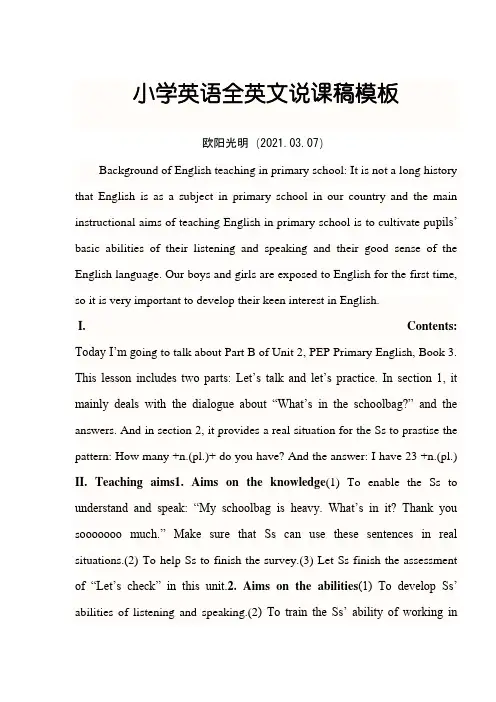
小学英语全英文说课稿模板欧阳光明(2021.03.07)Background of English teaching in primary school: It is not a long history that English is as a subject in primary school in our country and the main instructional aims of teaching English in primary school is to cultivate pu pils’ basic abilities of their listening and speaking and their good sense of the English language. Our boys and girls are exposed to English for the first time, so it is very important to develop their keen interest in English.I. Contents: Today I’m go ing to talk about Part B of Unit 2, PEP Primary English, Book 3. This lesson includes two parts: Let’s talk and let’s practice. In section 1, it mainly deals with the dialogue about “What’s in the schoolbag?” and the answers. And in section 2, it provides a real situation for the Ss to prastise the pattern: How many +n.(pl.)+ do you have? And the answer: I have 23 +n.(pl.) II. Teaching aims1. Aims on the knowledge(1) To enable the Ss to understand and speak: “My schoolbag is heavy. What’s in it? Thank you s ooooooo much.” Make sure that Ss can use these sentences in real situations.(2) To help Ss to finish the survey.(3) Let Ss finish the assessment of “Let’s check” in this unit.2. Aims on the abilities(1) To develop Ss’ abilities of listening and speaking.(2) To train the Ss’ ability of working ingroups.(3) To foster Ss’ abilities of communication and their innovation. 3. Aims on the emotion(1)To foster Ss’ consciousness of good co-operation and proper competition.(2) To lead Ss to show their loveliness to the poor.III. Key-points of this lesson(1) To help Ss ask and answer the question: What’s in it? (2) To enable Ss to study in groups and co-operate skillfully. (3) To develop Ss’ interest in English.IV. Difficult points(1) To help the Ss ask and answer the question “What’s in it?” and make sure they can use the plural nouns correctly. (2) To finish the survey by themselves.V. Teaching methods As we all know: the main instructional aims of learning English in primary school is to cultivate pupils’ basic abilit ies of listening and speaking and their good sense of the English language. So in this lesson I’ll mainly use “Task-based” teaching method. That is to say, I will let the Ss learn in real situations, finish a task by making a survey to help the Ss to get a better understanding of the key structure of the dialogue. I will arrange four kinds of activities: singing, guessing game, finishing a survey and having a competition. And in this lesson a recorder, CAI, school things and a printed form will be needed. Students should prepare some school things.VI. Teaching procedures and purposes of my designing.I’ll finish this lesson in five steps.Step 1. Warm-up and preview1. Free talk between T and Ss about things in the classroom.2. Sing the song together: Books and pencils.3. Do some TPR, for example: Show me your English book. Show me your crayon.4. Review the numbers by asking: “How many crayons do you have?” Purpose:It is important to form a better English learning surrounding for the Ss by singing and doing some total physical response and at the same time it provides situations to review learned knowledge for the next step.Step 2. Presentation Now I’ll mainly talk about this step. 1. Present the pattern:“My schoolbag is heavy.” “What’s in it?.”(1) Show a bag and say: “Look! I have a bag.” Carry it and say: “Oh, it is heavy. My schoolbag is heavy.” Help the Ss understand the meaning with the help of my body language. Then lead the Ss to read the sentence. Make sure they can say it correctly.(2) T: My schoolbag is heavy. Open the bag and say: “What’s in it? What’s in my schoolbag?”Take out a Chinese book. Then do the action again. Let the Ss read the sentence.2. Play a guessing game. Divide the whole class into four groups to have a competition. Let them guess: Wha t’s in the bag? How many? Purpose: To present the key structures one by one is much easier for the Ss to learn and grasp the meanings. Proper competition can arouse the Ss’ interest in English learning.3. With the help of the CAI to present the dialogue. Set a situation to help Ss understand: Two Ss are coming. One girl is carrying a heavy bag on her back. They are talking.Girl: My schoolbag is heavy.Boy: What’s in it? Girl: 20 story-books, 32 pencil, 9 rulers, 12 crayons and 30 picture-books. Etc.Boy: What will you do?Girl: They are for the poor. Boy: Great! I’ll bring some school things too.The boy comes back home and puts a lot of things into the bag. Then he goes to school again and gives them to a teacher. While he is taking them out, he is counting the numbers of all things.The teacher says: Thank you soooooooo much.4. Mention that we should take care of the poor.5. Play the cassette. Let the Ss listen and imitate the dialogue. Pay attention to their pronunciation and intonation.Purpose:CAI can provide a real situation for the Ss to understand the dialogue and the relationships between people better. Tell the Ss we should show our loveliness to the Ss.Step 3. Practice Divide Ss into groups of six children. Each one would finish the printed form by asking and answering: How many storybooks do you have? Find out which group finishes faster. Story books picture-books sharpeners crayons pencils erasers pencil-cases rulers Chen Jie 8 24 3 32 26 4 1 3Purpose: Task-based teaching method is used here to deve lop Ss’ ability of communication and also their ability of co-operation will be well trained.Step 4. Assessment Help Ss finish “Let’s check” of this unit and workbook.Purpose: To check the knowledge Ss have learned in this period. Step 5. Add-activity1. Let Ss tell each other how many school things they have after class. Tell their parents how many school things they have at home. 2. Take care of everything they have.Purpose: Revision is so important that Ss should speak English as much as they as in class or after class. It is necessary for the Ss to do some extensive exercises after class to consolidate the knowledge they learned.小学英语说课稿(英文万能版)●Good morning, my dear judges. I am_______, from____________. I’m glad to interpret my teaching design here.● The teaching content is Part, of Unit of PEP Primary English, Book .This unit is mainly aboutNow, I will explain the lesson from the following aspects.1.教学内容(体现教材的整合)Firstly, let’s focus on the analysis of teaching content.The lesson is a new one of Unit .It includes parts: and . In section 1, it mainly deals with these key words,. And, in section 2, it deals with the patterns:2.教学对象(根据不同年级的学生,描述其特点)Secondly, it is about the students.Our students are in Grade .They are active and curious, interested in new things.After learning English for years, they have some basic English background knowledge, so the teacher should attach importance to the communication with them, providing them the chances of using language.They have learnt English for years, and have already knownIt is not difficult for them to understand and use the language3.教学目标(根据具体内容定目标和要求)So, I set the following aims.By the end of the lesson, students will be able to read, recognize, and use these words:And, these sentences:By the end of the lesson,Ss can understand theand get useful information from the through attentive listening / reading.Ss are able to talk aboutSs can useto give suggestions onSs’ abilities of listening and speaking will be developed.(Affect; Learning strategies; cultural awareness.)In this lesson, the emotional aim isto help students cultivate and foster their abilities of working in groups.to foster Ss’ consciousness of good-cooperation and proper competition.to help Ss cultivate their abilities to analyze and solve problems independently.to foster Ss’ initiative and creativeness.to help Ss to recognize and identify the differences between Chinese and English cultures onto help Ss know some and comprehend theto make sure that Ss can useCorrectly and skillfully.to develop Ss’ interest in English.The difficult point is:The pronunciation of4.教法学法Fourthly, it talks about teaching methods.In this lesson, I will mainly use “Task-based teaching method”, “Communicative language teaching method” and “TPR teaching method”, and so on.5.教学过程①具体steps 根据具体内容定;②板书steps+ purpose 说明;③如有可能,同时完成layout设计;I will finish the lesson in steps.It will cost about mins.After greeting with the Ss, I will begin the lesson by singing the song together with the Ss.Purpose:The purpose of this is to form a better English learning surrounding for the Ss, and, at the same time, it provides situations to review the learnt knowledgefor the next step.It will cost about mins.With the help of the PPT, I set a situation ofbyto stimulate the Ss’ interest of the lesson.By playing the PPT, IAnd then,(板书layout) The purpose of this is to present the new words and sentences in the situation, which relates to the Ss’real life experiences, to help the Ss understand the language easily and naturally.After presenting each new word (by the guessing game), I will impart the knowledge of pronunciation rules in teaching the new words.It is called Phonics.It can facilitate the Ss’abilities to pronounce the words, and help them to remember the spelling of the words.(机械上口;有意义操练; let’s do; 课文对话表演;)It will cost mins, including 1 mechanical activity to help Ss to recognize and read the new words and sentences, and 2activities in the meaningful situations to make Ss use the new words with sentence structures in , to help Ss use the language in a real situation.Due to the Ss’ age, I makeThe purpose of this is to draw the whole Ss’attention to the spelling of the words.It is to help Ss to learnthrough a true situation.In this step, I will give Ss a free space to show their abilities.I willThen,Task-based teaching method and Communicative language teaching are used here.The activity is to develop Ss’ ability of communication, and also, their ability of cooperation will be well developed.Making a new dialogue is to check if Ss can usecorrectly and skillfully.(总结上课内容;德育渗透;作业布置;)In this step, I will guide the Ss to conclude the key wordsAnd sentencesAnd also, I willThepurpose of this is to stimulate Ss’interest of learning English and wide their knowledge about communication across cultures.6.板书设计And, this is my layout design.That’s all for my teaching design. Thank you a lot for listening. (GONG)小学英语全英文说课稿Today I’m going to talk about Part B of Unit 2, PEP Primary English, Book 3. This lesson includes two parts: Let’s talk and let’s practice. In secti on 1, it mainly deals with the dialogue about “What’s in the schoolbag?” and the answers. And in section 2, it provides a real situation for the Ss to practise the pattern: How many +n.(pl.)+ do you have? And the answer: I have … +n.(pl.) Teaching aims1. Aims on the knowledge(1) To enable the Ss to understand and speak: “My schoolbag is heavy. What’s in it? Thank you so much.” Make sure that Ss can use these sentences in real situations.(2) To help Ss finish the survey.2. Aims on the abilities(1) To de velop Ss’ abilities of listening and speaking.(2) To train the Ss’ ability of working in groups.(3) To foster Ss’ abilities of communication and their innovation.3. Aims on the emotion(1) To foster Ss’ consciousness of good co-operation and proper competition.(2) To lead Ss to show their loveliness to the poor.Key points(1) To help Ss ask and answer the question: What’s in it?(2) To enable Ss to study in groups and co-operate skillfully.(3) To develop Ss’ interests in English.Difficult points(1) To help the Ss ask and answer the question “What’s in it?” and make sure they can use the plural nouns correctly.(2) To finish the survey by themselves.Teaching procedures and purposes of my designing.I’ll finish this lesson in five steps.Step 1. Warm-up and preview1. Free talk between T and Ss about things in the classroom.2. Sing the song together: Books and pencils.3. Do some TPR, for example: Show me your English book. Show me your crayon.4. Review the numbers by asking: “How many crayons do you have?”Purpose: It is important to form a better English learning surrounding for the Ss by singing and doing some total physical response and at the same time it provides situations to review learned knowledge for the next step.Step 2. PresentationNow I’ll mainly talk about this step.1. Present the pattern: “My schoolbag is heavy.” “What’s in it?.”(1) Show a bag and say: “Look! I have a bag.” Carry it and say: “Oh, it is heavy. My schoolbag is heavy.” Help the Ss understand the meaning with th ehelp of my body language. Then lead the Ss to read the sentence. Make sure they can say it correctly.(2) T: My schoolbag is heavy.Open the bag and say: “What’s in it? What’s in my schoolbag?”Take out a Chinese book. Then do the action again. Let the Ss read the sentence.2. Play a guessing game. Divide the whole class into four groups to have a competition.Let them guess: What’s in the bag? How many? Purpose: To present the key structures one by one is much easier for the Ss to learn and grasp the m eanings. Proper competition can arouse the Ss’ interest in English learning.3. With the help of the CAI to present the dialogue. Set a situation to help Ss understand: Two Ss are coming. One girl is carrying a heavy bag on her back. They are talking.Girl: My schoolbag is heavy.Boy: What’s in it?Girl: 20 story-books, 32 pencil, 9 rulers, 12 crayons and 30 picture-books. Etc.Boy: What will you do?Girl: They are for the poor.Boy: Great! I’ll bring some school things too.The boy comes back home and puts a lot of things into the bag. Then he goes to school again and gives them to a teacher. While he is taking them out, he is counting the numbers of all things. The teacher says: Thank you so much.4. Mention that we should take care of the poor.5. Play the cassette. Let the Ss listen and imitate the dialogue.Pay attention to their pronunciation and intonation. Purpose: CAI can provide a real situation for the Ss to understand the dialogue and the relationships between people better. Tell the Ss we should show our loveliness to the Ss.Step 3. PracticeDivide Ss into groups of six children. Each one would finish the printed form by asking and answering: How many storybooks do you have? Find out which group finishes faster. Story books picture-books sharpeners crayons pencils erasers pencil-cases rulers Chen Jie 8 24 3 32 26 4 1 3 Purpose: Task-based teaching method is used here to develop Ss’ ability of communication and also their ability of co-operation will be well trained.Step 4. ConsolidationHelp S s finish “Let’s check” of this unit and workbook.Purpose: To check the knowledge Ss have learned in this period.Step 5. Extension1. Let Ss tell each other how many school things they have after class. Tell their parents how many school things they have at home.2. Take care of everything they have.Purpose: Revision is so important that Ss should speak English as much as they as in class or after class. It is necessary for the Ss to do some extensive exercises after class to consolidate the knowledge they learned.。
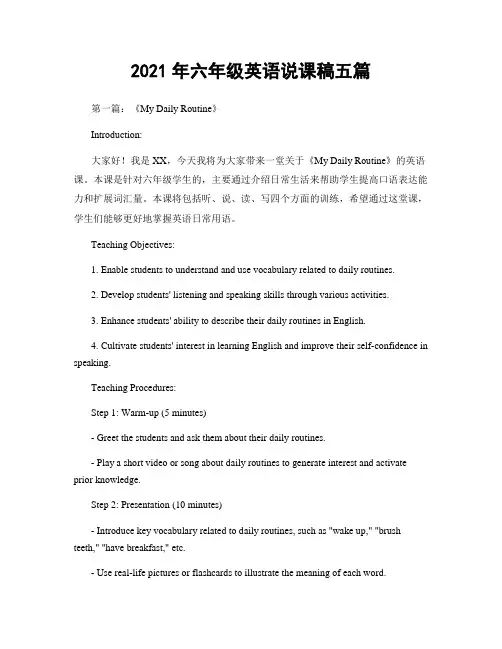
2021年六年级英语说课稿五篇第一篇:《My Daily Routine》Introduction:大家好!我是XX,今天我将为大家带来一堂关于《My Daily Routine》的英语课。
本课是针对六年级学生的,主要通过介绍日常生活来帮助学生提高口语表达能力和扩展词汇量。
本课将包括听、说、读、写四个方面的训练,希望通过这堂课,学生们能够更好地掌握英语日常用语。
Teaching Objectives:1. Enable students to understand and use vocabulary related to daily routines.2. Develop students' listening and speaking skills through various activities.3. Enhance students' ability to describe their daily routines in English.4. Cultivate students' interest in learning English and improve their self-confidence in speaking.Teaching Procedures:Step 1: Warm-up (5 minutes)- Greet the students and ask them about their daily routines.- Play a short video or song about daily routines to generate interest and activate prior knowledge.Step 2: Presentation (10 minutes)- Introduce key vocabulary related to daily routines, such as "wake up," "brush teeth," "have breakfast," etc.- Use real-life pictures or flashcards to illustrate the meaning of each word.- Model the pronunciation and ask students to repeat after you.Step 3: Listening (15 minutes)- Play an audio recording of a conversation about daily routines.- Ask students to listen carefully and answer comprehension questions.- Provide feedback and check the answers as a whole class.Step 4: Speaking (20 minutes)- Divide the class into pairs or small groups.- Ask students to take turns describing their own daily routines to their partners.- Encourage students to use the vocabulary and sentence structures learned earlier.- Monitor the students' conversations and provide assistance as needed.Step 5: Reading and Writing (15 minutes)- Distribute a reading passage about a typical day in the life of a student.- Ask students to read the passage silently and underline any unfamiliar words.- Discuss the meaning of the new words as a class.- In pairs or individually, have students write a short paragraph describing their own daily routines.Step 6: Review and Wrap-up (5 minutes)- Review the key vocabulary and sentence structures learned in the lesson.- Summarize the main points of the lesson and provide positive feedback to students.- Assign homework, such as writing a diary entry about their daily routines.Assessment:During the speaking activity, I will assess students based on their ability to accurately use the vocabulary and sentence structures related to daily routines. I will also take note of their pronunciation and fluency. Additionally, I will review the written paragraphs to evaluate their understanding and application of the lesson content.Conclusion:通过本堂课的学习,学生们将能够掌握与日常生活相关的词汇,提高听说读写的能力,并能够用英语描述自己的日常生活。
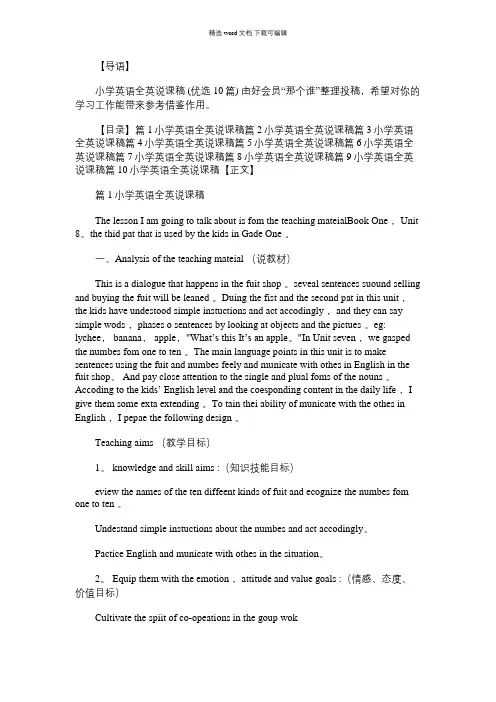
【导语】小学英语全英说课稿 (优选10篇) 由好会员“那个谁”整理投稿,希望对你的学习工作能带来参考借鉴作用。
【目录】篇1小学英语全英说课稿篇2小学英语全英说课稿篇3小学英语全英说课稿篇4小学英语全英说课稿篇5小学英语全英说课稿篇6小学英语全英说课稿篇7小学英语全英说课稿篇8小学英语全英说课稿篇9小学英语全英说课稿篇10小学英语全英说课稿【正文】篇1小学英语全英说课稿The lesson I am going to talk about is fom the teaching mateialBook One ,Unit 8。
the thid pat that is used by the kids in Gade One 。
一、Analysis of the teaching mateial (说教材)This is a dialogue that happens in the fuit shop 。
seveal sentences suound selling and buying the fuit will be leaned 。
Duing the fist and the second pat in this unit ,the kids have undestood simple instuctions and act accodingly ,and they can say simple wods ,phases o sentences by looking at objects and the pictues 。
eg: lychee, banana, apple,"What’s this It’s an apple。
"In Unit seven ,we gasped the numbes fom one to ten 。
The main language points in this unit is to make sentences using the fuit and numbes feely and municate with othes in English in the fuit shop。
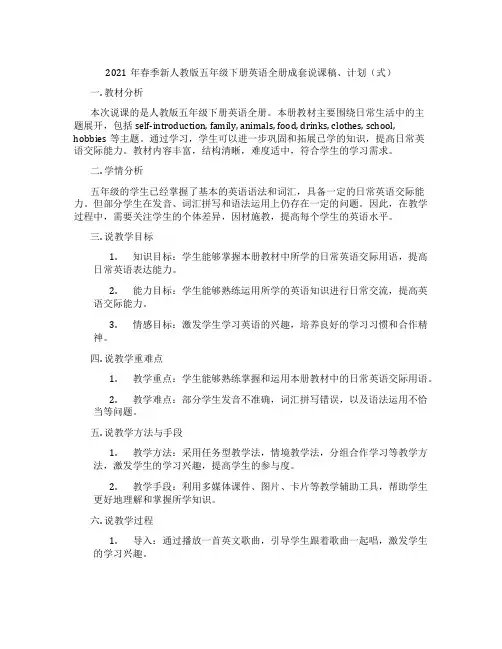
2021年春季新人教版五年级下册英语全册成套说课稿、计划(式)一. 教材分析本次说课的是人教版五年级下册英语全册。
本册教材主要围绕日常生活中的主题展开,包括self-introduction, family, animals, food, drinks, clothes, school, hobbies等主题。
通过学习,学生可以进一步巩固和拓展已学的知识,提高日常英语交际能力。
教材内容丰富,结构清晰,难度适中,符合学生的学习需求。
二. 学情分析五年级的学生已经掌握了基本的英语语法和词汇,具备一定的日常英语交际能力。
但部分学生在发音、词汇拼写和语法运用上仍存在一定的问题。
因此,在教学过程中,需要关注学生的个体差异,因材施教,提高每个学生的英语水平。
三. 说教学目标1.知识目标:学生能够掌握本册教材中所学的日常英语交际用语,提高日常英语表达能力。
2.能力目标:学生能够熟练运用所学的英语知识进行日常交流,提高英语交际能力。
3.情感目标:激发学生学习英语的兴趣,培养良好的学习习惯和合作精神。
四. 说教学重难点1.教学重点:学生能够熟练掌握和运用本册教材中的日常英语交际用语。
2.教学难点:部分学生发音不准确,词汇拼写错误,以及语法运用不恰当等问题。
五. 说教学方法与手段1.教学方法:采用任务型教学法,情境教学法,分组合作学习等教学方法,激发学生的学习兴趣,提高学生的参与度。
2.教学手段:利用多媒体课件、图片、卡片等教学辅助工具,帮助学生更好地理解和掌握所学知识。
六. 说教学过程1.导入:通过播放一首英文歌曲,引导学生跟着歌曲一起唱,激发学生的学习兴趣。
2.新课展示:利用多媒体课件展示本节课的主题,引导学生进行讨论,引出本节课的主要内容。
3.课堂讲解:讲解本节课的主要知识点,通过示例、情景模拟等方式,让学生在实际情境中学习和运用所学知识。
4.小组活动:将学生分成若干小组,进行小组讨论和合作,共同完成任务,提高学生的实践能力和合作精神。
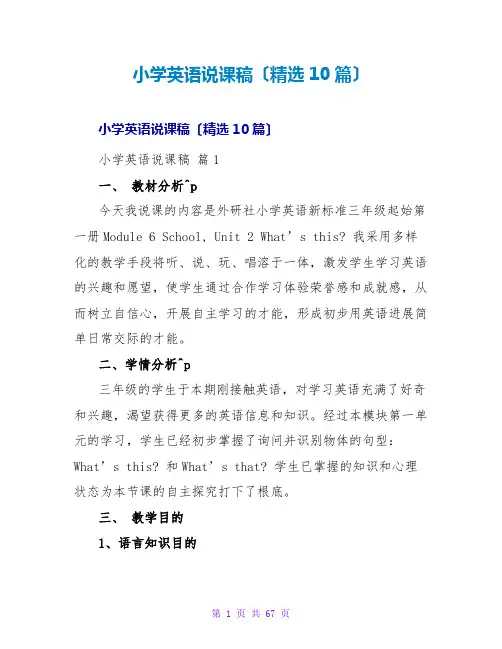
小学英语说课稿〔精选10篇〕小学英语说课稿〔精选10篇〕小学英语说课稿篇1一、教材分析^p今天我说课的内容是外研社小学英语新标准三年级起始第一册Module 6 School, Unit 2 What’s this? 我采用多样化的教学手段将听、说、玩、唱溶于一体,激发学生学习英语的兴趣和愿望,使学生通过合作学习体验荣誉感和成就感,从而树立自信心,开展自主学习的才能,形成初步用英语进展简单日常交际的才能。
二、学情分析^p三年级的学生于本期刚接触英语,对学习英语充满了好奇和兴趣,渴望获得更多的英语信息和知识。
经过本模块第一单元的学习,学生已经初步掌握了询问并识别物体的句型:What’s this? 和What’s that? 学生已掌握的知识和心理状态为本节课的自主探究打下了根底。
三、教学目的1、语言知识目的(1) 让学生能听、说、认、读pen,pencil,book,bag等单词。
(2) 通过学习让学生纯熟掌握句型What’s this? 和What’s that?2、学习技能目的:(1) 能听懂Let’s do中的指令并做出相应动作,如Point to th e …(2) 根据图片或在场景下进展简单的英语交流和表达,培养学生灵敏运用所学知识进展交流的才能.3、情感态度目的(1) 通过学习活动,使学生有兴趣听、说英语,培养学生注意观察、乐于模拟的良好习惯和主动竞争的竟识。
(2) 让学生在鼓励性评价中树立学习英语的自信心。
(3) 通过小组活动培养学生合作交流才能,从而让学生意识到学习英语的重要意义。
(4)充分利用教材所提供的学习资,实现自由参与与创新,能主动与别人交流,并克制交流中的困难,使交际顺利进展。
四、教学重难点1、学习新单词 pen,pencil,book,bag ,能正确认读。
2、稳固已学句型:What’s this? 和What’s that? 并能用It’s a…作出相应的答复。
五、课前准备教具准备:课文录音;带单词的物品图片;实物pen,pencil,book,bag;魔法包;奖品(贴画)。
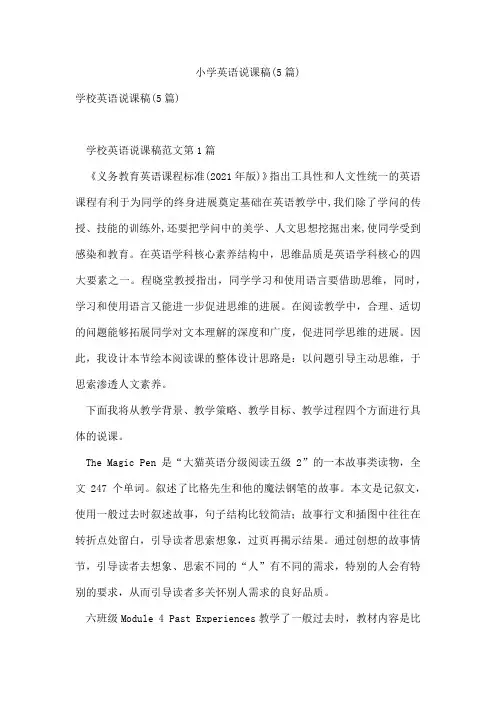
小学英语说课稿(5篇)学校英语说课稿(5篇)学校英语说课稿范文第1篇《义务教育英语课程标准(2021年版)》指出工具性和人文性统一的英语课程有利于为同学的终身进展奠定基础在英语教学中,我们除了学问的传授、技能的训练外,还要把学问中的美学、人文思想挖掘出来,使同学受到感染和教育。
在英语学科核心素养结构中,思维品质是英语学科核心的四大要素之一。
程晓堂教授指出,同学学习和使用语言要借助思维,同时,学习和使用语言又能进一步促进思维的进展。
在阅读教学中,合理、适切的问题能够拓展同学对文本理解的深度和广度,促进同学思维的进展。
因此,我设计本节绘本阅读课的整体设计思路是:以问题引导主动思维,于思索渗透人文素养。
下面我将从教学背景、教学策略、教学目标、教学过程四个方面进行具体的说课。
The Magic Pen是“大猫英语分级阅读五级2”的一本故事类读物,全文247个单词。
叙述了比格先生和他的魔法钢笔的故事。
本文是记叙文,使用一般过去时叙述故事,句子结构比较简洁;故事行文和插图中往往在转折点处留白,引导读者思索想象,过页再揭示结果。
通过创想的故事情节,引导读者去想象、思索不同的“人”有不同的需求,特别的人会有特别的要求,从而引导读者多关怀别人需求的良好品质。
六班级Module 4 Past Experiences教学了一般过去时,教材内容是比较简洁地谈论自己过去做的事,而讲故事是一般过去时最重要的运用情景,借助这个绘本故事阅读的拓展,能更综合地呈现这个时态的运用,让同学更深化地体验这个时态。
六班级同学,抽象规律思维正处于全面进展阶段,能够进行初步的辩证思维。
这阶段的同学尚未把握科学的阅读方法,需要老师和家长供应适当的阅读方法指导和环境条件,促进他们阅读策略和力量的进展,养成良好的阅读习惯。
同学在三班级语文课本中已经学习了《神笔马良》的故事,这与本课时的绘本故事异曲同工,所以马良的故事可以成为同学已有的背景学问,其情节的进展与猜测方法可以“正迁移”到本课的故事学习中。

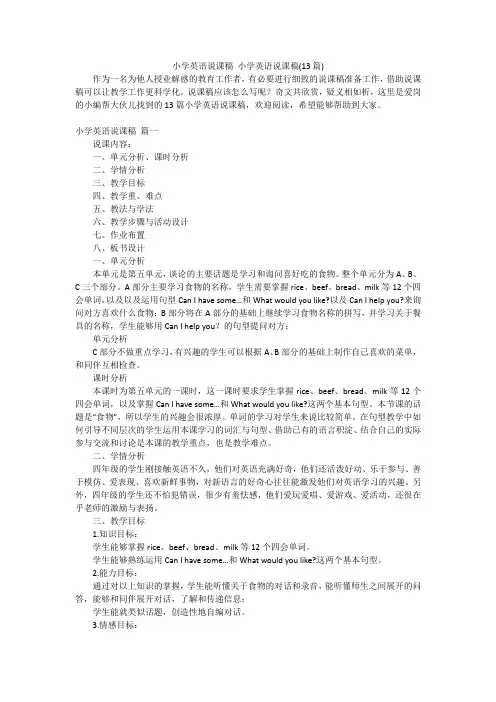
小学英语说课稿小学英语说课稿(13篇)作为一名为他人授业解惑的教育工作者,有必要进行细致的说课稿准备工作,借助说课稿可以让教学工作更科学化。
说课稿应该怎么写呢?奇文共欣赏,疑义相如析,这里是爱岗的小编帮大伙儿找到的13篇小学英语说课稿,欢迎阅读,希望能够帮助到大家。
小学英语说课稿篇一说课内容:一、单元分析、课时分析二、学情分析三、教学目标四、教学重、难点五、教法与学法六、教学步骤与活动设计七、作业布置八、板书设计一、单元分析本单元是第五单元,谈论的主要话题是学习和询问喜好吃的食物。
整个单元分为A、B、C三个部分。
A部分主要学习食物的名称,学生需要掌握rice、beef、bread、milk等12个四会单词,以及以及运用句型Can I have some…和What would you like?以及Can I help you?来询问对方喜欢什么食物;B部分将在A部分的基础上继续学习食物名称的拼写,并学习关于餐具的名称,学生能够用Can I help you?的句型提问对方;单元分析C部分不做重点学习,有兴趣的学生可以根据A、B部分的基础上制作自己喜欢的菜单,和同伴互相检查。
课时分析本课时为第五单元的一课时,这一课时要求学生掌握rice、beef、bread、milk等12个四会单词,以及掌握Can I have some…和What would you like?这两个基本句型。
本节课的话题是“食物”,所以学生的兴趣会很浓厚。
单词的学习对学生来说比较简单。
在句型教学中如何引导不同层次的学生运用本课学习的词汇与句型、借助已有的语言积淀、结合自己的实际参与交流和讨论是本课的教学重点,也是教学难点。
二、学情分析四年级的学生刚接触英语不久,他们对英语充满好奇,他们还活泼好动、乐于参与、善于模仿、爱表现、喜欢新鲜事物,对新语言的好奇心往往能激发他们对英语学习的兴趣。
另外,四年级的学生还不怕犯错误,很少有羞怯感,他们爱玩爱唱、爱游戏、爱活动,还很在乎老师的激励与表扬。
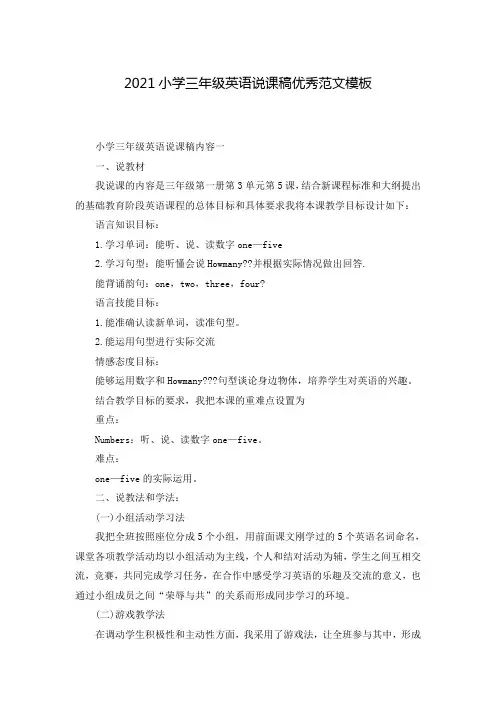
2021小学三年级英语说课稿优秀范文模板小学三年级英语说课稿内容一一、说教材我说课的内容是三年级第一册第3单元第5课,结合新课程标准和大纲提出的基础教育阶段英语课程的总体目标和具体要求我将本课教学目标设计如下:语言知识目标:1.学习单词:能听、说、读数字one—five2.学习句型:能听懂会说Howmany??并根据实际情况做出回答.能背诵韵句:one,two,three,four?语言技能目标:1.能准确认读新单词,读准句型。
2.能运用句型进行实际交流情感态度目标:能够运用数字和Howmany???句型谈论身边物体,培养学生对英语的兴趣。
结合教学目标的要求,我把本课的重难点设置为重点:Numbers:听、说、读数字one—five。
难点:one—five的实际运用。
二、说教法和学法:(一)小组活动学习法我把全班按照座位分成5个小组,用前面课文刚学过的5个英语名词命名,课堂各项教学活动均以小组活动为主线,个人和结对活动为辅,学生之间互相交流,竞赛,共同完成学习任务,在合作中感受学习英语的乐趣及交流的意义,也通过小组成员之间“荣辱与共”的关系而形成同步学习的环境。
(二)游戏教学法在调动学生积极性和主动性方面,我采用了游戏法,让全班参与其中,形成师生互动,提高教学效果。
尤其是教授a、e、i、o、u和1-5时用的TPR(全身动作反应法)。
这是比较流行的一种儿童学习英语过程中可以采用的活动,可以通过动作来表现儿童对输入的语言理解是否达到了内化的程度。
(三)鼓励法课堂评价主要以鼓励性评价为主分别采用了师评、互评为主要方式,课上教师恰当的使用激励性评语和赠送小礼物的方法让学生渴望成功的心理得到满足,这也是激励学生积极投身英语学习的一个最简单而有效的方法。
三、说教具依据英语教学的直观性,趣味性、实践性的教学原则,结合合作学习和任务型教学的新理念,我利用了自制的星图、小红旗、卡片、磁带等媒体设计教学,学习则利用骰子、小贴纸等积极参与教学活动。
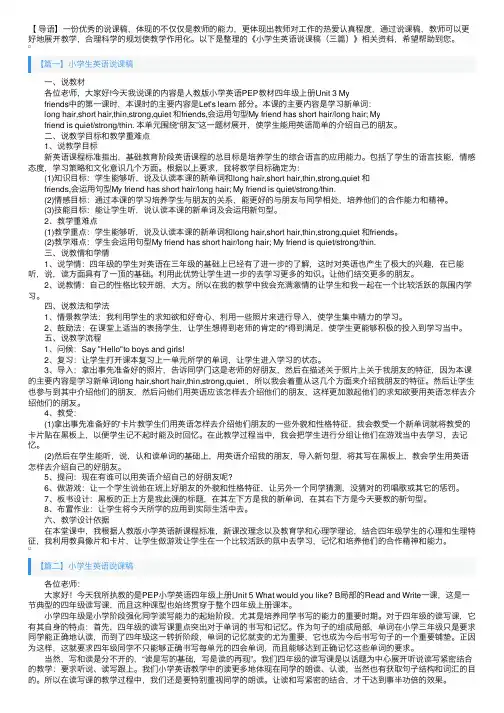
【导语】⼀份优秀的说课稿,体现的不仅仅是教师的能⼒,更体现出教师对⼯作的热爱认真程度,通过说课稿,教师可以更好地展开教学,合理科学的规划使教学作⽤化。
以下是整理的《⼩学⽣英语说课稿(三篇)》相关资料,希望帮助到您。
【篇⼀】⼩学⽣英语说课稿 ⼀、说教材 各位⽼师,⼤家好!今天我说课的内容是⼈教版⼩学英语PEP教材四年级上册Unit 3 My friends中的第⼀课时,本课时的主要内容是Let's learn 部分。
本课的主要内容是学习新单词: long hair,short hair,thin,strong,quiet 和friends,会运⽤句型My friend has short hair/long hair; My friend is quiet/strong/thin. 本单元围绕“朋友”这⼀题材展开,使学⽣能⽤英语简单的介绍⾃⼰的朋友。
⼆、说教学⽬标和教学重难点 1、说教学⽬标 新英语课程标准指出,基础教育阶段英语课程的总⽬标是培养学⽣的综合语⾔的应⽤能⼒。
包括了学⽣的语⾔技能,情感态度,学习策略和⽂化意识⼏个⽅⾯。
根据以上要求,我将教学⽬标确定为: (1)知识⽬标:学⽣能够听,说及认读本课的新单词和long hair,short hair,thin,strong,quiet 和 friends,会运⽤句型My friend has short hair/long hair; My friend is quiet/strong/thin. (2)情感⽬标:通过本课的学习培养学⽣与朋友的关系,能更好的与朋友与同学相处,培养他们的合作能⼒和精神。
(3)技能⽬标:能让学⽣听,说认读本课的新单词及会运⽤新句型。
2、教学重难点 (1)教学重点:学⽣能够听,说及认读本课的新单词和long hair,short hair,thin,strong,quiet 和friends。
(2)教学难点:学⽣会运⽤句型My friend has short hair/long hair; My friend is quiet/strong/thin. 三、说教情和学情 1、说学情:四年级的学⽣对英语在三年级的基础上已经有了进⼀步的了解,这时对英语也产⽣了极⼤的兴趣,在已能听,说,读⽅⾯具有了⼀顶的基础。

[说明]小学英语课说课稿共含3篇,由好的会员投稿推荐,希望以下多篇范文对你的学习工作能带来参考借鉴作用。
第1篇小学英语课说课稿这篇小学英语课说课稿范文是我们精心挑选的,但愿对你有参考作用。
教学目的及重难点分析会说会用这些句子My bedroom is small but nice.The living room is in the middle.It is big and bright.The bedrooms are clean and tidy.会说会用会写这些单词bedroom living room kitchen bathroom clean and tidy课前准备:教师准备bedroom living room kitchen bathroom clean and tidy单词卡片。
师生分别准备 bedroom living room kitchen bathroom 的图片。
教师准备第 67页挂图。
教学过程热身(Warming up)师生对话引出话题Tto A)Whhere do you liveA: I live in/on… .TTo B)Do you live in a villageB:Yes/No.T: (To all the students) Where do I live展示第 67页挂图,喜悦地说。
I live in a new flat. It is very nice. Welcome to my new flat.Ss: Thank you.新课展示(New Presentation)学习课文词汇老师展示准备的67页主图。
表现的很热情的样子,对学生们说介绍自己的new flat ,然后进行课文讲解。
1)Welcome to my new flat.It is on the second floor.理解会读会认短语on the second floor.second 序数词,第二。
Good afternoon, ladies. I am number_______. I’m glad toshare my lesson with you.欧阳光明(2021.03.07)My teaching content today is Part of Unit of PEP Primary English, Book . (Recycle_)This unit is mainly aboutNow, I will explain the lesson from the following aspects.1.教学内容 (Contents)Firstly, let’s focus on the analysis of teaching content.The lesson is a new one of Unit .This unit introduces and develops the theme of “___________”, Ss are expected to master the new words___________________ and to use the sentence patterns___________________ in proper situation. The teaching material mainly describes ___________________ , and it shows all of the new knowledge points.Therefore, it is in the important position of this unit. If Ss can master it well, it will be benefit for them to learn the rest of the unit.2.教学目标 (Teaching aims)Secondly, it is about the teaching aims.According to the new curriculum standard and the syllabus, and afterstudying the teaching material and the facts of the Ss, I set the teaching aims as follows:1, Knowledge objects1) Ss can understand the content correctly. They can read and play the dialogue;2) Ss can listen, read, speakandwrite the core words_______________;3) Ss can use the sentence patterns ____________- properly.2, Ability objects1) To train Ss’ abilities of listening and speaking;2) To train Ss’ ability of working in groups.3, Moral objectsTo foster Ss’consciousness of good cooperation and proper competition.3.Important and difficult pointsAccording to the syllabus,the important points: have Ss fully understand the content, help them to read and play the dialogue.The difficult points: 1) Help Ss to read the dialogue fluently, and help them to read and play the dialogue; 2) make sure they can read the core words correctly.4.教法学法(Teaching methods)Fourthly, it talks about teaching methods.In this lesson, I will mainly use “Task-based teaching method”,“Communicative language teaching method”and “TPR teaching method”, and so on.5.教学过程Next, let’s focus on the teaching procedures.I will finish the lesson in steps.It will cost about mins.After greeting with the Ss, I will begin the lesson by singing the song together with the Ss.Purpose:The purpose of this is to form a better English learning surrounding for the Ss, and, at the same time, it provides situations to review the learned knowledgefor the next step.It will cost about mins.With the help of the PPT, I set a situation ofbyto stimulate the Ss’ interest of the lesson.By playing the PPT, IAnd then,(板书layout)The purpose of this is to present the new words and sentences in the situation, which relates to the Ss’ real life experiences, to help the Ss understand the language easily and naturally.After presenting each new word (by the guessing game), I will impart the knowledge of pronunciation rules in teaching the new words.It is called Phonics.It can facilitate the Ss’ abilities to pronounce the words, and help them to remember the spelling of the words.It will cost mins, including 1 mechanical activity to help Ss to recognize and read the new words and sentences, and 2activities in the meaningful situations to make Ss use the new words with sentence structures in , to help Ss use the language in a real situation.Due to the Ss’ age, I makeThe purpose of this is to draw the whole Ss’ attention to the spelling of the words.It is to help Ss to learnthrough a true situation.In this step, I will give Ss a free space to show their abilities.I willThen,Task-based teaching method and Communicative language teaching are used here.The activity is to develop Ss’ ability of communication, and also, their ability of cooperation will be well developed.Making a new dialogue is to check if Ss can usecorrectly and skillfully.In this step, I will guide the Ss to conclude the key wordsAnd sentencesAnd also, I willThe purpose of this is to stimulate Ss’ interest of learning English and wide their knowledge about communication across cultures.6.板书再次介绍(Talking about the blackboard design again)And, this is my layout design.That’s all for my teaching design. Thank you a lot for listening.。
2021年小学英语说课稿15篇小学英语说课稿1一、说教材(一)分析本课内容在教材中的地位和作用。
本课内容是全书第二模块的第二单元,属于我任课第二模块的第三课时,第一单元耗时两个课时,今天要讲述的第二单元为本模块的第三课时。
课文内容是第一单元买电脑的内容延伸,主要讲述千和百大数字的英语及数字表达方法。
本单元分为四个部分,第一部分为一段大明选择钢笔的描述,第二部分是听录音,选择正确的图片,意在培养孩子的听力,第三部分是一首关于卖电脑的诗歌,最后一个部分是一个游戏,还是练习在第一单元中出现的几个形容词,加深孩子的印象。
(二)本节课的教学目标1.知识目标:花费多少钱的英语表示方法及读法的掌握。
2.能力目标:能够说出自己所买物品的价格。
3.情感目标:培养学生合理理财的观念。
(三)教学重难点本课的教学重点就是数字的英语表示方法,应当在课堂中不断操练,确保每一个孩子都能够正确说出几千几百数字的表示方法;本课的教学难点是课文正文的熟练朗读和诗歌的熟练朗读,需要教师巧用方法,激发学生的记忆。
二、说教法为了顺利完成以上的教学目标,更好地突出重点,突破难点,按照学生的认识规律,我采用讲读、直观演示、交际、愉快教学相结合的方法;在课堂教学中,我将结合愉快教学,激发学生学习英语的兴趣。
教学不是简单的知识传授,为了不使学习感到枯燥无味,我采用多种教学手段,如多媒体电化教学,比较形象、直观,在教学过程中启发、引导学生思维,培养不同层次的学生大胆用英语交际的能力三、说学法根据本课句型特点及学生现有的知识水平,我准备引导学生采用听、看、读、想、说的方法来学习本课,通过听、看,达到有所思,有所得,能说出问题的关键,帮助学生掌握学习重点,多表扬,勤鼓励,便不同层次的学生都有学习教育积极性,在知识上均有所提高。
四、说教学过程及设计意图活动一:激趣导入首先以一个数字游戏调动学生的积极性,然后开始向学生介绍价钱的表示方法,教授costs,举例让学生熟练运用。
小学英语课程内容的说课稿小学英语课程内容的说课稿范文1.1教材内容本节教材主要是、表达人体部位head,fa ___,ear,nose,mouth,eye,并能运用简单的句子描述。
1.2教材的地位在日常生活中,我们最熟悉的莫过于自己的身体各部位,如何让学生学会用英语来表达自己的身体各部位是本单元所要学习的教学内容。
通过学生学会用英语来表达自己的身体部位,发展他们的语言表达能力,同时进一步培养他们的语言综合运用能力。
2.1教学目标依据教材的内容和学生的年龄特征及认知水平确定以下目标:知识目标:能听、说、认读head 和五个有关五官的词汇:fa___,ear,nose,mouth,eye;听懂、理解句子look at me. this is my nose/eye/….;快速反应:touch your head /eye/…能力目标:培养学生听,做,说,读的能力,增进身体各部分的'协调能力,语言表达能力。
情感目标:让学生通过运用语言来完成学习任务, ___成功,从而引发和培养学生学习英语的内在动机,最终使他们形成英语学习的积极态度。
2.2 教学重难点本课的教学重点是让学生能听、说、认读head和五个有关五官的词汇。
教学难点是学生能将这六个有关人体部位的词汇运用到简单的英语句子中表达,突破重点和难点的关键是结合低年级学生喜欢跳跳、唱唱、画画,喜欢游戏的特点,通过let’s do快速反应,使单调的知识溶进生动的活动之中,让学生在听,做,动的过程中,掌握知识,并灵活地运用。
3.1教法设计为了顺利完成以上教学目标,更好地突出重点,突破难点,按照学生的认识规律,我采用了讲读、直观演示、愉快教学相结合的方法,层层递进,激发学生的学习兴趣,充分调动他们学习的积极性,保持他们强烈的好奇心和旺盛的求知欲,进而促使他们由兴趣发展到产生要学好它的志趣。
3.2学法指导鉴于本课词汇的特点及学生现有知识水平,我准备引导学生听、看、读、想、说来逐步引导学生学会表达自己的身体部位,发展学生的语言思维和运用能力。
小学英语说课稿范文英文版英文版本的说课稿,对于英语水平非常高的小学英语老师应该不再话下。
下面是 ___给大家的小学英语说课稿范文英文版,供大家参阅!【Analysis of the Teaching Material】(I)STATUS AND FUNCTION1.This unit is a revision unit, so it covers all municative language knowledge learned from Unit 7 to Unit 11.2.This lesson is the first one of Unit 12. So if the students can learn this lesson well, it will be helpful to ___ke the students learn the rest of this unit.3.This lesson is a dialogue about keeping fish. Such topic is related to daily life, so it is helpful to raise learning interests of students and it will be also helpful to improve their spoken English.(II)TEACHING AIMS AND DEMANDSKnowledge objects1. To ___ke the Ss know how to keep fish, birds or any other ani ___l by learning the dialogue of this lesson.2. To give a reinfor ___d practi ___ in the use of the Modal Verbs and some useful expressions for ___ suggestions.Ability objects3. To improve students’ listening and speaking ability by reading and practising the dialogue.4. To develop students’ municative ability by learning the useful expressions for ___ suggestions and replying.Moral objects5. To enable the students to love life and ani ___ls, protect the nature and enviro ___ent.(III)TEACHING KEY POINTS:1.To ___ke the Ss grasp and understand the way of ___ suggestions and reply in daily life.2.To enable the students to use useful expressions for___ suggestion and replying in their own dialogues related to the daily life.(IV)TEACHING DIFFICULTIES:1. The usage of the Modal Verbs ,especially usage for ___ suggestions.2. Using the learned phrases and senten ___ patterns to ___ke suggestions and replying.(V)TEACHING AIDS:Multi-media puter; OHP(overhead projector); tape recorder; software: Powerpoint or Authorware【Teaching Methods】1>Five Steps Approach.2>Communicative Approach.【Studying Ways】1. Teach the students how to be suessful language learners.2. Teach the students how to ___ster dialogues and how to municate with others.【Teaching Pro ___dure】Step 1 RevisionGet the students to give some ani ___ls’ names they know by asking the students the following question: Can you give us some names of different ani ___ls you know? This step is employed to revise the words related the ani ___ls. At the same time draw the students’ attention to the topic about ani ___ls.Step 2【Lead-in】Sign to the students to be quiet and close their books. Then start a free talk with the students. Use puter to show some pictures of different pets, such as dogs, cats etc. Ask the students several questions about raising pets. These questions are employed to warm up the students and raise the interests of the students to speak English in class on the topics they like and familiar with.Good morning, everyone!Today, I’ll say something about Unit 9 Part A in Book 4 of Oxford English.Background on the refor ___tion of curriculum, this book can connect the life and act, emphasize the interest and experien ___ of the Ss, the pictures are active and vivid. Grade four is the initial stage of English learning, so it stresses on the emotion of the Ss, creates a well beginning for the Ss. This Unit has 7 parts, we’ll learn Part A___inly, it embo ___s the repeating characterize. Review the learned language points “Where’s…”and the new language points will be represented in the following units. So this unit forms connecting links with a special meaning in this book.The content of this period is to use “Where’s\are…”to determine the pla ___. And aording to the contents and the fact of the Ss, I establish the following three teaching aims of this period:The first one: students can listen, read, say and spell the following words: a glass, a fridge, an egg, bread and a table.The second one: students can listen, read, say and write the following daily expressions: What’s for breakfast?Have some jui ___ then.The third one: students can listen, read, say and write the following senten ___ patterns: Where’s\Where arethe\my…It’s \They’re…There’s no …in \on \near…I think the most difficult point of this period is to___ke sure the students can use the patterns “Where’s\Where are…and There is no …in\on\near…” in theirdaily life correctly.And I will use some pictures, words and senten ___ cards, a tape recorder and the multi-media puter to help me achieve the aims.The task-based method, municated method, group cooperate method will be used in this period.To aomplish the aims, I design the following steps:Step 1 Songs and the game arousers the emotion.In order to attract the Ss’ attention and construct an atmosphere of learning English, I let the students sing some English songs and play the game “Simon says”. At the same time the game can review the prep, serve the knowledge as foil and consist the appearan ___ of the knowledge.Step 2 Change class to life, happy to say.The substan ___ of language is munication and the enviro ___ent of munication is life. So when I present the senten ___ pattern “What’s for breakfast?” I first show a clock to elicit the time for breakfast, teach the senten ___. Then show my own photo of having breakfast, Ss ask and guess. In this way I can attract Ss’ attention, encourage Ss to ask Qs with the new knowledge.Most of the Ss have learnt the senten ___ pattern: Where’s…? so I design a task for Ss to help Helen findthe food and drinks for breakfast, and teach the new language points: Where are…?They’re … Meanwhile stick the senten ___s on the Bb.After some practi ___ by asking and answering, I present the next language points:There’s no …in\on\near…Have …then.And I will stick these senten ___ patterns on the Bb. Finally I’ll let the Ss do pair works to consolidate them.Step 3 Listen to the tape and Ss imitate to read and say.As the new refor ___tion of curriculum, emphasized the traditional class attach importan ___ to the mechanicalteaching, neglect the experien ___ and participation, for example, the five-step method. So in this lesson, after presentation, I ask Ss to listen to the tape with three Qs, read in different roles and in pairs, then try to recite the text.Step 4 Ss be the ___in body, T ___kes a guider.In class, Ss play as a host, and the T ___kes an influen ___ on guiding, help Ss to act the learnt dialogue, it can stress the position of the Ss, and arouse their interest.Then I show a carton with no voi ___, ask Ss to ___ke a dialogue in pairs.There are lots of ways to consolidate the new knowledge. Playing game is a good way. So aording to the physiology of Ss, I hold a group petition during the game, ask Ss to finish the blanks. In this way can develop Ss’ good habits and achieve the aim of ___stering the learned knowledge in situation.Step 5 Change class to life, learn by themselves.Is this the end of the class? I don’t think so. If there is an end, I think it should be in the life. So I extend this class, encourage Ss to use the learned to municate with each other in their life.In a word, the whole period is based on tasks, which are designed from easy steps to steps that are challenging. When the Ss are carting out the tasks, they can acquire infor ___tion, knowledge, and have their ability and skills trained.Thank you!看过小学英语说课稿范文英文版的人还看了:1.2.3.4.5.模板,内容仅供参考。
小学英语说课稿模板(共6篇)编辑整理:尊敬的读者朋友们:这里是精品文档编辑中心,本文档内容是由我和我的同事精心编辑整理后发布的,发布之前我们对文中内容进行仔细校对,但是难免会有疏漏的地方,但是任然希望(小学英语说课稿模板(共6篇))的内容能够给您的工作和学习带来便利。
同时也真诚的希望收到您的建议和反馈,这将是我们进步的源泉,前进的动力。
本文可编辑可修改,如果觉得对您有帮助请收藏以便随时查阅,最后祝您生活愉快业绩进步,以下为小学英语说课稿模板(共6篇)的全部内容。
篇一:小学英语说课万能模板小学英语说课稿尊敬的各位评委老师大家上午好:我是英语组()号,我今天说课的题目是——(板书:课题)如:unit 1 i like football.下面我将从以下四个方面进行说课:说教材、说教学目标、说教学重难点、说教法和学法、说教学程序(板书黑板)。
(可适当加手势、眼神、动作)五个方面来对本课作具体的阐述。
结合教材的重难点以及学科的特点,利用多种教学方法,在愉快轻松的气氛中进行教学,从视、听、说等方面使学生得到了语言的训练,提高了学生学习英语的兴趣。
我从下面先说一下第一方面:一、说教材1.教材的地位及作用《》是科普版小学四年级下册第()单元的第()篇课文,本课重点围绕学生对几种体育运动是否喜爱这个题材开展多种教学活动,通过学习句型 i like ?\i dont like ?,让学生能够用英语表达出自己的思想和感受。
它是整个模块的重点,占有很重要的地位,它为后两个单元的学习奠定了基础。
2.教学目标知识目标:学习掌握单词 football. basketball. table tennis。
morning exercise,学习运用句型 i like ?\i dont like ?。
能力目标:培养学生运用英语的能力。
德育目标:教育学生热爱体育运动,勤于体育锻炼。
确立教学目标的依据:根据《英语新课程标准》的要求,小学阶段的英语课主要是激发学生学习英语的兴趣;培养学生对英语学习的积极态度,使他们建立学习英语的自信心;培养学生一定的语感和良好的语音、语调,为英语的进一步学习打下基础。
2022年关于小学说课稿范文汇总5篇篇一:小学英语说课稿范文Good morning, everyone!Today, I am going to talk about my English class. My topic is Unit 3 in the textbook, which is about food. This unit focuses on vocabulary related to food and teaches students how to express their likes and dislikes.First, let's start with the warm-up activity. I will show the students some pictures of different kinds of food and ask them to name the food in English. This will help activate their prior knowledge and get them thinking about the topic.Next, I will introduce the new vocabulary words. I will use flashcards to show the words and pronounce them clearly. Then, I will ask the students to repeat after me to practice their pronunciation. After that, I will divide the class into small groups and give each group a set of picture cards. The students will take turns describing the pictures using the new vocabulary words. This activity will help them practice using the words in context.After the vocabulary practice, we will move on to the main activity. I will show the students a dialogue between two people ordering food in a restaurant. I will read the dialogue aloud and ask the students to listen carefully. Then, I will ask them some comprehension questions to check their understanding. After that, I will ask the students to work in pairs and role-play the dialogue. This activity will help them practice using the language in a realistic situation.Finally, we will end the class with a game. I will divide the class into two teams and give each team a set of cards with different food pictures. One student from each team will come to the front of the class and I will say a word related to food. The students will have to find the corresponding picture card and show it to me. The team that finds the correct card first will get a point. This game will review the vocabulary words and make the class more interactive and fun.That's all for my English class. Thank you for your attention!篇二:小学数学说课稿范文Good morning, everyone!Today, I am going to talk about my math class. My topic is addition and subtraction within 100. This topic is important for students to develop their mental calculation skills and understand the concept of place value.First, I will start the class with a warm-up activity. I will show the students some flashcards with numbers on them and ask them to read the numbers aloud. This will help activate their prior knowledge and get them thinking about numbers.Next, I will introduce the concept of addition and subtraction. I will use manipulatives, such as counters or blocks, to demonstrate the concept. I will show the students how to add and subtract numbers within 100 using these manipulatives. Then, I will ask the students to work in pairs and practice adding and subtracting numbers using the manipulatives. This hands-on activity will help them understand the concept better.After the hands-on activity, we will move on to mental calculation. I will show the students some addition and subtraction problems and ask them to solve them mentally. I will encourage them to use different strategies, such as counting on or breaking numbers apart, to solve the problems. Then, I will ask the students to work in pairs and create their own addition and subtraction problems for their partners to solve. This activity will help them practice their mental calculation skills and develop their problem-solving abilities.Finally, we will end the class with a game. I will divide the class into two teams and give each team a set of cards with addition and subtraction problems on them. One student from each team will come to the front of the class and I will say a problem aloud. The students will have to solve the problem and show the answer to me. The team that gets the correct answer first will get a point. This game will review the addition and subtraction skills and make the class more interactive and fun.That's all for my math class. Thank you for your attention!篇三:小学语文说课稿范文Good morning, everyone!Today, I am going to talk about my Chinese class. My topic is a Chinese poem called "The Little Swallow". This poem is about a little swallow's journey from the south to the north.First, I will start the class with a warm-up activity. I will show the students some pictures of swallows and ask them to describe what they see. This will help activate their prior knowledge and get them thinking about the topic.Next, I will introduce the poem to the students. I will read the poem aloud and ask the students to listen carefully. Then, I will ask them some comprehension questions to check their understanding. After that, I will ask the students to work in pairs and recite the poem together. This activity will help them practice their pronunciation and memory skills.After the recitation, we will move on to the main activity. I will divide the class into small groups and give each group a set of picture cards. The students will have to put the picture cards in the correct order to retell the story of the poem. This activity will help them understand the structure of the poem and develop their storytelling abilities.Finally, we will end the class with a creative activity. I will ask the students to draw a picture of a swallow and write a short paragraph about the swallow's journey. They can use the vocabulary and sentence patterns from the poem to describe the journey. This activity will encourage their creativity and writing skills.That's all for my Chinese class. Thank you for your attention!篇四:小学音乐说课稿范文Good morning, everyone!Today, I am going to talk about my music class. My topic is rhythm and beat. This topic is important for students to develop their sense of rhythm and learn how to keep a steady beat.First, I will start the class with a warm-up activity. I will play a piece of music and ask the students to clap their hands or tap their feet along with the beat. This will help activate their sense of rhythm and get them thinking about the topic.Next, I will introduce the concept of rhythm and beat. I will use a drum or a rhythm instrument to demonstrate the beat. I will ask the students to listen to the beat and try to clap their hands or tap their feet along with it. Then, I will ask them to work in pairs and take turns being the leader and setting the beat for their partner to follow. This activity will help them develop their sense of rhythm and learn how to keep a steady beat.After the rhythm and beat practice, we will move on to a song. I will teach the students a simple song with a catchy beat. I will sing the song and ask the students to listen carefully. Then, I will ask them to sing along with me. After that, I will ask the students to work in groups and create their own actions to go along with the song. This activity will help them practice their coordination and creativity.Finally, we will end the class with a game. I will divide the class into two teams and give each team a set of rhythm cards. One student from each team will come to the front of the class and I will say a rhythm pattern aloud. The students will have to find the corresponding rhythm card and show it to me. The team that finds the correct card first will get a point. This game will review the rhythm and beat skills and make the class more interactive and fun.That's all for my music class. Thank you for your attention!篇五:小学体育说课稿范文Good morning, everyone!Today, I am going to talk about my physical education class. My topic is basketball dribbling. This topic is important for students to develop their ball-handling skills and coordination.First, I will start the class with a warm-up activity. I will ask the students to jog around the basketball court to get their bodies warmed up. Then, I will ask them to do some stretching exercises to loosen up their muscles. This will help prevent injuries during the class.Next, I will introduce the basic dribbling skills. I will demonstrate the correct dribbling technique, such as keeping the ball low and close to the body, using fingertips instead of palms, and using both hands. Then, I will ask the students to practice dribbling the ball while walking around the court. I will walk around and give individual feedback and guidance to each student. This activity will help them develop their ball-handling skills and coordination.After the dribbling practice, we will move on to a dribbling game. I will divide the class into two teams and set up a small game. The students will have to dribble the ball and try to score a basket. The team that scores the most baskets wins the game. This game will help them apply their dribbling skills in a realistic situation and make the class more interactive and fun.Finally, we will end the class with a cool-down activity. I will ask the students to do some stretching exercises to relax their muscles and prevent muscle soreness. Then, I will ask them to sit down and take deep breaths to calm down and cool down their bodies.That's all for my physical education class. Thank you for your attention!。
小学英语说课稿相关小学英语说课稿相关模板“说课”有利于提高教师理论素养和驾驭教材的能力,也有利于提高教师的语言表达能力,因而受到广大教师的重视,登上了教育研究的大雅之堂。
那么,有关英语的说课稿是怎么样的呢?下面大家就随一起去了解一下吧!今天我说课的内容是外研社小学英语新标准三年级起始第一册module 6 school, unit2 what’s this? 我采用多样化的教学手段将听、说、玩、唱溶于一体,激发学生英语的兴趣和愿望,使学生通过合作学习体验荣誉感和成就感,从而树立自信心,发展自主学习的能力,形成初步用英语进行简单日常交际的能力。
三年级的学生于本期刚接触英语,对学习英语充满了好奇和兴趣,渴望获得更多的英语信息和知识。
经过本模块第一单元的学习,学生已经初步掌握了询问并识别物体的句型:what’s this? 和what’s that? 学生已掌握的知识和心理状态为本节课的自主探究打下了基础。
1、语言知识目标(1) 让学生能听、说、认、读pen,pencil,book,bag等单词。
(2) 通过学习让学生熟练掌握句型 what’s this? 和what’s that?2、学习技能目标:(1) 能听懂let’s do中的指令并做出相应动作,如point to the …(2) 根据 ___或在场景下进行简单的英语交流和表达,培养学生灵活运用所学知识进行交流的能力.3、情感态度目标(1) 通过学习活动,使学生有兴趣听、说英语,培养学生注意观察、乐于模仿的良好习惯和主动竞争的竟识。
(2) 让学生在鼓励性评价中树立学习英语的自信心。
(3) 通过小组活动培养学生合作交流能力,从而让学生意识到学习英语的重要意义。
(4)充分利用教材所提供的学习资源,实现自由参与与创新,能主动与他人交流,并克服交流中的困难,使交际顺利进行。
1、学习新单词 pen,pencil,book,bag ,能正确认读。
2、巩固已学句型:what’s this? 和what’s that? 并能用it’s a…作出相应的回答。
教具准备:课文录音;带单词的物品 ___;实物pen,pencil,book,bag;魔法包;奖品(贴画)。
学具准备:单色物品的 ___(学生课前画好)为了突破这堂课的重、难点,根据小学生好奇、好胜、好动、模仿力强、表现欲旺盛等生理和心理特点,我主要采取了以下教法和学法。
(一) 小组活动学习法把全班分成四个大组(两行为一组),分别用数量单词命名,并书写在黑板的左边或右边。
课堂各项教学活动均以小组活动为主线,结对或全班活动为辅,学生互相交流、探究,共同完成学习任务,在合作中 ___学习英语的乐趣及交流的意义,也通过小组成员之间“荣辱与共”的关系而形成同步学习的环境。
(二) 情境教学法给学生不断创设各种真实的场景,促使学生说英语。
(三) 课堂评价主要以鼓励性评价为主。
课上恰当使用激励性和奖励个人贴画、小组奖红旗(画在黑板上)的方法,让学生渴望成功的心理得到满足,这也是激励学生积极投身英语学习的一个最简单而有效的方法。
老师操作起来也比较方便。
(一)热身复习,营造学习英语的气氛。
1、歌曲导入,激发学生学习的兴趣教育家托尔斯泰说过:“成功的教学所必须的'不是强制,而是激发学生的兴趣,激发学生参与学习的兴趣,是新课导入的关键。
精彩的课堂开头,不仅能使学生迅速地兴奋起来,而且还会使学生把学习当成一种自我需要,自然地进入学习新知的情景。
因此,在热身的时候,首先让学生演唱歌曲“plese stand up ”,并做上相应的动作,这样的导入能很快吸引住学生,还渲染了学生学习英语的良好气氛。
同时,歌曲中的物品也可勾起学生们对已学物品单词的回忆,对复习句型what’s this? 和what’s that?作好铺垫。
2、复习旧知,培养自信教师出示tom的 ___,谈话向孩子们引出本节课的新朋友:“it’s tom.”,并让学生热情地和他打招呼。
告诉学生们他是amy的弟弟,今年才三岁。
小tom有些物品不认识,由于刚和大家见面,有些害羞,要老师代问,让孩子们帮帮他。
孩子们对帮助他人都比较热心,反应都很积极。
于是老师拿着tom的 ___,在教室里四处走动,随意拿起一件物品或指向一件物品,向学生提问:what’s this? 或what’s that?让学生作出相应的回答。
适时还可用what colour is it?进行询问,借以复习表示颜色的单词。
大力夸奖乐于助人的娃娃。
这样不仅复习了旧知识,渲染了学习英语的良好气氛,而且渗透了思想品德教育。
(二)会话导入新知,促进语言实际运用能力的提高。
学生在一个平等尊重的氛围中,他们的思维是放松的,敢于说、敢于参与教学。
教师要真心诚意地把学生当成学习的主人,努力提高“导”的艺术,从而在教学中恰到好处地去启发、点拔、尽可能地给学生多一点思考的时间,多一点活动的余地,多一点表现自己的机会,这样才能使课堂氛围充满活力。
因此,这个环节我是这样设计的:1、教师拿着tom的 ___继续指向教室里的物品,向学生提问。
课前教师在离讲台较近的墙壁两侧和较远的后墙两边分别贴上pen,pencil和book,bag的 ___,分别使用what’s this? 和what’s that?向学生提问,学生可用中文来回答。
教师引导用“it’s a…”来回答,自然引出新单词,进行单词教学。
2、游戏——变一变。
老师先出示魔法包,把实物pen,pencil,book,bag一件件地特意让学生看到后,再把它们放进“魔法包”中,然后让一名学生___,从“魔法包”中握住一件物品,让其余学生猜是什么。
若猜对了就把物品拿出来,并让另一名学生 ___找出相应的单词卡片,全班进行单词练读。
学生们对“魔法包”充满了好奇,而所学的单词又是孩子们非常熟悉的文具物品,从而学习起来非常带劲,能起到很好的巩固作用。
通过齐读、指名读、开火车读、看口形猜单词等多种形式的操练,孩子们能十分轻松地掌握单词的认读。
对读得对、读得好的个人和小组要给以及时的鼓励,调动学习的兴趣和积极性。
(三)呈现新知,合作互动。
在小学英语课堂中使学生保持一种积极的紧张感,能够激发他们学习的外部动机,引发他们一系列的自主活动,促进外部动机向内部动机的转化。
1、游戏——say and point请四位学生上来,分别站在四个不同的方位,手里分别拿着实物pen,pencil,book,bag再请一名学生发出指令:point to the…其余学生做出相应的动作,以达到对新单词的熟练掌握。
这个活动完全由学生来操作,既锻炼了学生的胆量和能力,又激发了学生学习的兴趣。
2、演一演。
这个部分由学生导学。
指派一生扮演tom,在教室随意走动,指向任一物品,用what’s this? 和what’s that?进行询问,其余学生扮演amy作答,以答到操练句型的目的。
为了激发学生学习的积极性和主动性,可多抽几名学生扮演tom练习。
这个环节主要是操练学生能正确使用what’s this? 和what’s that?来提问。
对能正确使用this和 that来询问的学生要加以大力表扬和奖励。
3、小组活动:ask and answer以学习小组(四人)为单位,摆出pen,pencil,book,bag等文具,可故意将其中的一件放远一些。
然后指派一人分别用what’s this? 和what’s that?进行询问,其他学生作答。
依次轮流进行,借以达到熟练掌握句型的目的。
若组内成员不懂,其他成员帮助,团结一心,完成任务。
教师巡视指导。
4、学习课文 what’s this?(1)学生打开书,结合课文插图,听课文录音,理解文意。
(2)再听录音,生逐句模仿读。
教师适时正音。
(3)趣味操练——多种形式赛读:男女生分角色读;指名分角色读;小组赛读。
优胜者分别奖个人贴画、奖小组小红旗。
各种方式的赛读,从多方面激发学生学习英语的兴趣,培养自信心,让他们 ___到成功的快乐。
(四)巩固新知,拓展练习。
1、完成运用任务(1):赛一赛——将 ___24页的activity 3设计为一个抢答赛。
教师出示单色物品,用what’s this?询问,学生抢答。
在这个环节,教师要注意引导学生加上颜色作答。
不仅巩固了新知,也复习了旧知。
这个练习有一定的难度,教师要多加诱导,多给孩子思考的余地。
通过努力,相信孩子们一定能完成得很好的。
对答得对的要大加赞扬和奖励,比如说:呀,你真了不起!能说那么长的英语句子了!太棒了!2、完成运用任务2:将 ___ 25页的activity 5设计为小组活动——show and ask学生展示出课前画好的单色物品 ___,在小组内互相用what’s this? 和what’s that?来进行问答。
提醒学生在问时把 ___拿出来,做出合适的动作;在答时尽量加上表示颜色的词,教师巡视指导。
此任务的设计,重视了对学生思维能力、观察能力的培养,特别是对学生合作学习能力的培养,让学生们在师生,生生,小组等不同的合作方式中,学会倾听,学会评价,为学生的终身学习奠定基础。
(五) 课堂小结和课堂延伸1、总结小组的战利品,(包括个人的贴画和黑板上小组的小红旗)学生掌声祝贺并鼓励未获胜的小组继续努力,为激发下节课的学习气氛打下基础。
2、布置课外作业——我来当当小老师。
将所学的单词或英语句子教教你的家人或朋友。
并将你当小老师的情况在下节英语课上向老师和同学汇报。
此环节将课堂延伸至课外,培养了学生的运用能力,让孩子的家人和朋友也来 ___学习英语的快乐,从而更加激发孩子学习英语的欲望,真切体验学习英语的成功带来的喜悦,达到学以至用的目的。
本节课不论是新知的呈现,还是游戏的设计,都是以学生的自主探究学习为中心,充分调动了学生学习英语的积极性,让学生全员积极参与到课堂,在玩中学,学中用,提高了课堂实效,培养了学生学习英语的兴趣。
我相信通过这样的教学,充分让学生主体参与、体验感悟、游戏巩固,是一定能圆满实现课堂教学任务的。
附:板书设计Module 6 School Unit 2 What’s this? What’s this?It’s a red pen. yellow pencil. What’s that?It’s a blue bag. green book.模板,内容仅供参考。